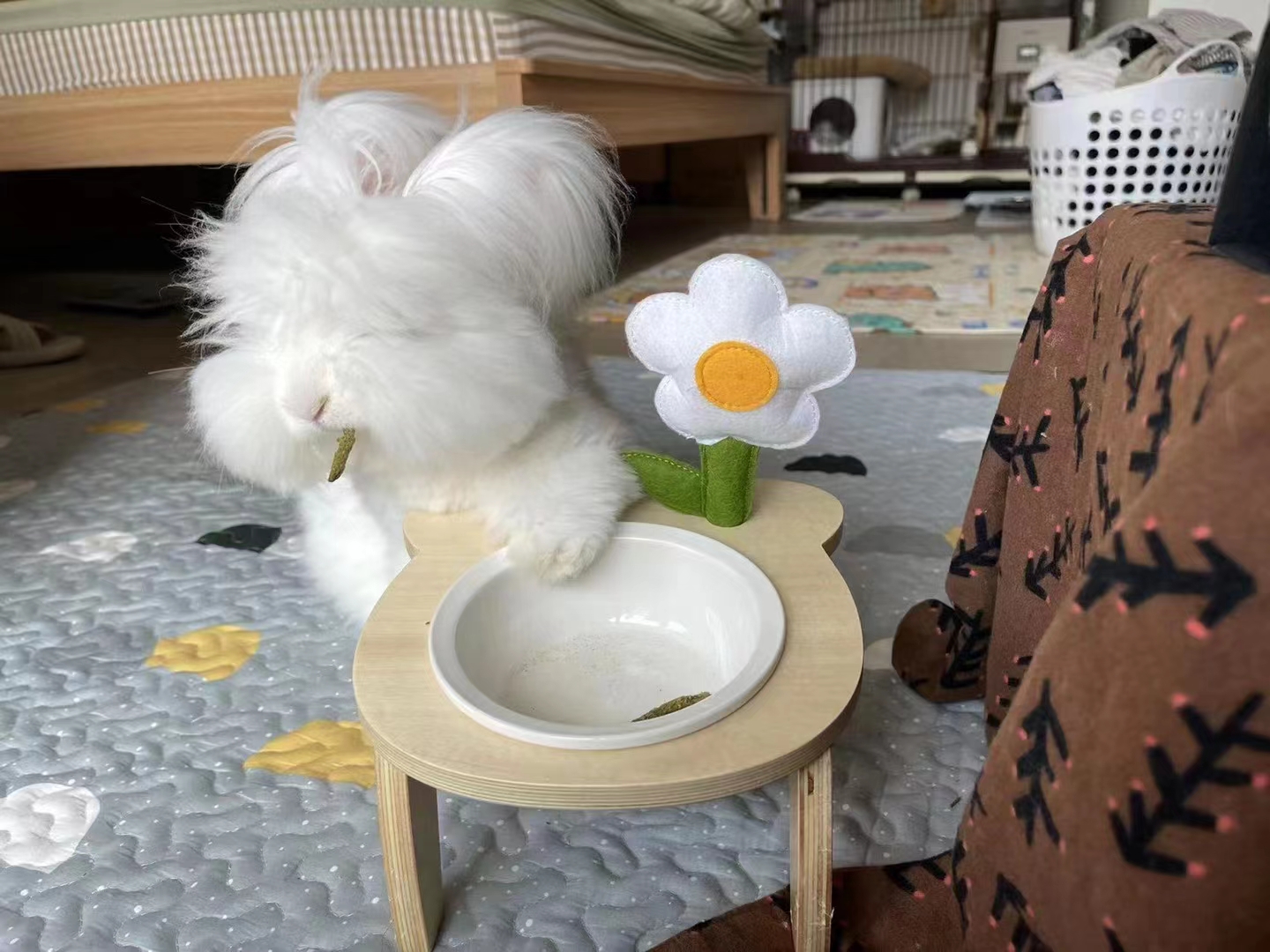


長毛兔養(yǎng)殖廠是怎么保障每個長毛兔溫度適合的?
 發(fā)布日期:2025-06-07
來源:http://m.osovetu.com 發(fā)布人:創(chuàng)始人
發(fā)布日期:2025-06-07
來源:http://m.osovetu.com 發(fā)布人:創(chuàng)始人
在規(guī)模化長毛兔養(yǎng)殖中,維持適宜的舍內(nèi)溫度是保障兔群健康、提升毛皮品質(zhì)的核心要素。通過環(huán)境調(diào)控技術、建筑工藝優(yōu)化及精細化管理的綜合應用,養(yǎng)殖廠構建起動態(tài)平衡的溫濕度控制系統(tǒng),確保兔只始終處于生長狀態(tài)。
In large-scale breeding of long haired rabbits, maintaining a suitable indoor temperature is a core element in ensuring the health of the rabbit population and improving fur quality. Through the comprehensive application of environmental regulation technology, building process optimization, and refined management, the breeding plant has established a dynamically balanced temperature and humidity control system to ensure that rabbits are always in the best growth state.
一、長毛兔的生理溫度閾值與需求
1、 Physiological temperature threshold and demand of long haired rabbits
適宜溫度范圍
Suitable temperature range
成年兔適環(huán)境溫度為15-25℃,新生仔兔需30-32℃保溫環(huán)境,斷奶后逐步過渡成兔溫度。某科研機構監(jiān)測顯示,溫度波動超±5℃時,兔群采食量下降,換毛周期延長。
The optimal ambient temperature for adult rabbits is 15-25 ℃, while newborn rabbits require a 30-32 ℃ insulation environment, gradually transitioning to adult rabbit temperature after weaning. Monitoring by a certain research institution shows that when the temperature fluctuation exceeds ± 5 ℃, the feed intake of the rabbit population decreases and the shedding cycle is prolonged.
溫度應激影響
The impact of temperature stress
低溫導致基礎代謝率提升,飼料轉化率降低;高溫引發(fā)熱應激,公兔精液品質(zhì)下降,母兔受胎率降低。某規(guī)模化兔場數(shù)據(jù)表明,30℃以上環(huán)境持續(xù)72小時,母兔流產(chǎn)率上升。
Low temperature leads to an increase in basal metabolic rate and a decrease in feed conversion rate; High temperature induces heat stress, leading to a decrease in semen quality in male rabbits and a decrease in conception rate in female rabbits. Data from a large-scale rabbit farm shows that when the temperature remains above 30 ℃ for 72 hours, the miscarriage rate of female rabbits increases.
二、建筑設計與被動式溫控
2、 Architectural Design and Passive Temperature Control
朝向與通風廊道
Orientation and ventilation corridor
兔舍采用坐北朝南布局,利用自然光照調(diào)節(jié)晝夜溫差。某示范基地設計通風廊道,夏季風速提升,加速舍內(nèi)空氣置換,降低熱積聚。
The rabbit house adopts a north facing south layout, utilizing natural light to regulate the temperature difference between day and night. A certain demonstration base is designed with a ventilation corridor, which increases the wind speed in summer, accelerates the air exchange inside the building, and reduces heat accumulation.
保溫隔熱構造
Thermal insulation structure
墻體采用240mm厚頁巖磚+50mm擠塑板復合結構,傳熱系數(shù)降,冬季夜間舍溫波動小于3℃。屋頂設置300mm空氣間層,搭配反射膜,減少輻射熱侵入。
The wall adopts a composite structure of 240mm thick shale bricks and 50mm extruded polystyrene board, with a reduced heat transfer coefficient and a temperature fluctuation of less than 3 ℃ at night in winter. The roof is equipped with a 300mm air layer and reflective film to reduce the intrusion of radiant heat.

地面防潮與導熱
Ground moisture prevention and thermal conductivity
發(fā)酵床地面鋪設地暖管,冬季水溫維持28-30℃,結合生物發(fā)酵產(chǎn)熱,使地面溫度穩(wěn)定在20℃以上,減少仔兔腹瀉發(fā)生率。
Lay underfloor heating pipes on the fermentation bed floor, maintain a water temperature of 28-30 ℃ in winter, and combine with biological fermentation heat production to stabilize the floor temperature above 20 ℃, reducing the incidence of diarrhea in young rabbits.
三、主動式環(huán)境調(diào)控技術
3、 Active environmental regulation technology
智能溫控系統(tǒng)
Intelligent temperature control system
部署溫濕度傳感器網(wǎng)絡,通過物聯(lián)網(wǎng)平臺實時調(diào)控設備。某兔場應用后,舍內(nèi)溫度波動范圍控制在±1℃以內(nèi),能耗降低。
Deploy a network of temperature and humidity sensors to control devices in real-time through an IoT platform. After application in a certain rabbit farm, the temperature fluctuation range inside the house was controlled within ± 1 ℃, and energy consumption was reduced.
分級供暖方案
Graded heating scheme
仔兔保育區(qū)采用遠紅外陶瓷加熱板,局部升溫32℃,成兔區(qū)使用空氣能熱泵,能效比達3.8,較電加熱。
The juvenile rabbit conservation area uses far-infrared ceramic heating plates to locally raise the temperature to 32 ℃, while the adult rabbit area uses air source heat pumps with an energy efficiency ratio of 3.8, which is more energy-efficient than electric heating.
蒸發(fā)降溫裝置
Evaporative cooling device
夏季啟用濕簾-風機降溫系統(tǒng),當舍溫超28℃時自動啟動,可使舍內(nèi)溫度降低,配合噴霧,同時控制呼吸道疾病傳播。
The wet curtain fan cooling system is used in summer. When the room temperature exceeds 28 ℃, it will automatically start, which can reduce the temperature in the room, cooperate with spray disinfection, and control the spread of respiratory diseases.
四、氣流組織與空氣質(zhì)量管理
4、 Airflow organization and air quality management
縱向通風模式
Vertical ventilation mode
兔舍兩端安裝變頻風機,通過負壓通風形成定向氣流,風速控制在0.2-0.5m/s,避免賊風直吹。某兔場實測顯示,該模式使氨氣濃度降10ppm以下。
Install variable frequency fans at both ends of the rabbit house to create directional airflow through negative pressure ventilation, with wind speed controlled at 0.2-0.5m/s to avoid direct blowing of thief wind. The actual test at a rabbit farm shows that this mode reduces the ammonia concentration to below 10ppm.
空氣過濾與凈化
Air filtration and purification
進風口設置初效+活性炭過濾網(wǎng),攔截粉塵及有害氣體。某養(yǎng)殖基地應用后,兔群呼吸道疾病發(fā)病率降低。
The air inlet is equipped with an initial effect and activated carbon filter to intercept dust and harmful gases. After application in a breeding base, the incidence rate of respiratory diseases in rabbits decreased.
五、分階段精準管理策略
5、 Staged precise management strategy
仔兔保育期
Baby Rabbit Care Period
0-1月齡仔兔置于保溫箱內(nèi),底部鋪設電熱板,頂部懸掛紅外燈,營造30-32℃微環(huán)境,濕度控制在60%-65%,減少黃尿病發(fā)生。
0-1 month old rabbits are placed in an insulated box with an electric heating plate at the bottom and an infrared lamp hanging at the top to create a micro environment of 30-32 ℃. The humidity is controlled at 60% -65% to reduce the occurrence of yellow urine disease.
育成期過渡
Transition during the incubation period
4周齡后逐步降低保溫設備功率,每周下調(diào)1-2℃,8周齡完全適應成兔舍溫度。某兔場采用此方案,成活率提升。
Gradually reduce the power of the insulation equipment after 4 weeks of age, lowering it by 1-2 ℃ per week, until it fully adapts to the temperature of the rabbit house at 8 weeks of age. A certain rabbit farm adopts this plan, which improves the survival rate.
種兔特殊管理
Special management of breeding rabbits
妊娠母兔舍溫保持18-22℃,避免高溫導致的死胎、弱胎。公兔舍溫度控制在20℃左右,保障精液活力,某實驗室檢測顯示,該溫度下精子畸形率。
Pregnant female rabbits should maintain a temperature of 18-22 ℃ to avoid stillbirths and weak fetuses caused by high temperatures. The temperature in the public rabbit house is controlled at around 20 ℃ to ensure the vitality of semen. A laboratory test showed that the sperm deformity rate is the lowest at this temperature.
本文由長毛兔友情奉獻.更多有關的知識請點擊:http://m.osovetu.com我們將會對您提出的疑問進行詳細的解答,歡迎您登錄網(wǎng)站留言.
This article is a friendly contribution from Long haired Rabbit For more information, please click: http://m.osovetu.com We will provide detailed answers to your questions. You are welcome to log in to our website and leave a message